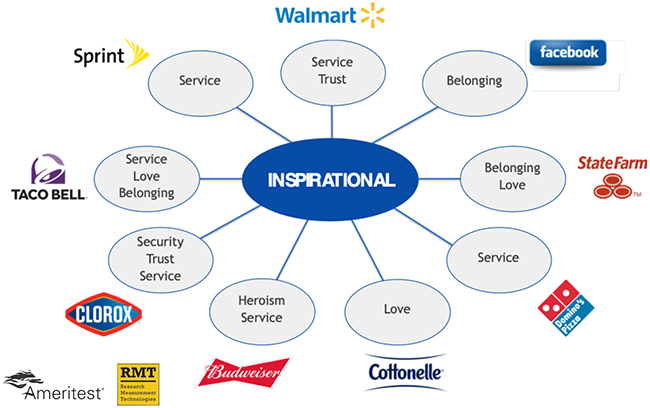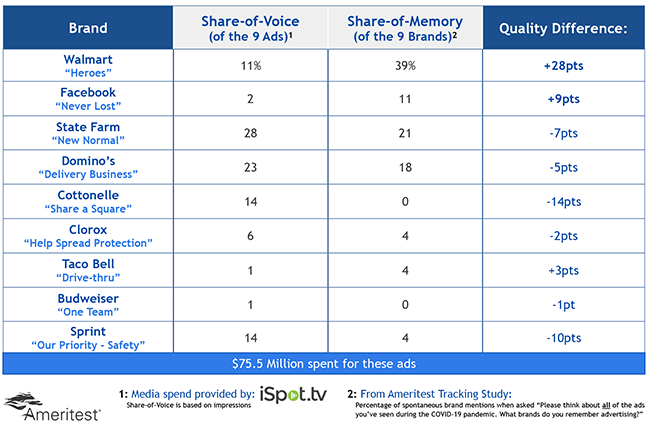Here to help
Editor's note: Based in Seattle, Charles Young is founder and CEO of research firm Ameritest. Emily Higgins is vice president of client services, Ameritest, Chicago. Richard Bilbee is research director, Ameritest, Chicago. Russ Turpin is associate director, Ameritest, Chicago.
We are all living through a dangerous and economically disruptive time – a time we will remember for the rest of our lives. We must focus on the health and safety of our family, friends, co-workers and fellow citizens first. But as businesspeople and, in particular, as brand stewards we must also think of the needs of our customers. So now is a good time to reflect on what your brand means. What does it stand for in the hearts and minds of your customers?
Brands are marks of trust and are familiar touchstones in our lives. They provide continuity of experience so that whatever changes tomorrow, brands provide an emotional anchor to our past selves. All of these things are terribly important while COVID-19 sows fear and doubt.
Some may suggest that remaining silent and waiting for current events to blow over is the best thing for a brand-advertiser to do. But there’s truth in the saying that you find your real friends in times of trouble. Silence leads to fear and fear isolates us from each other more than quarantine, so now is exactly the right time to reinforce the power of a brand to connect us to each other. Brand advertising can be a force for good in today’s uncertain world.
Our advice to our clients is to do something in the name of your brand or at least find ways to be supportive of what others are doing. The key is that this requires a shift in point of view: Brands cannot talk about themselves or play the hero of the story. Rather, they should play a supporting role in any communications. To do otherwise would be seen as a form of profiteering.
The virus is a danger to our bodies, our economic health and our emotional well-being. Great brand advertising can help protect us against the last two of these three challenges.
Understand what would work best
Ameritest partnered with several research companies to better understand what advertising approaches would work best during this time of crisis. Ameritest used our brand advertising research system, called BARS, to link together ad-testing measurements with in-market tracking and brand image performance. We conducted 2,000 online consumer interviews with sampling help from research company Dynata. We collected media spending data from iSpot TV to measure share-of-voice and compare it to share-of-memory results. And we used DriverTags from Research Measurement Technologies to link the meaning of key advertising visual elements back to advertising ROI.
As of the middle of May 2020, advertisers had spent a total of $1.7 billion on COVID-19-related advertising across 595 brands in 15 industries with 1,186 TV commercials. Our study looked at a subset of these, across nine major advertisers who spent $75 million over the preceding three months. Here is what we learned.
Collectively, this set of nine ads might be thought of as a virtual campaign that all serve the common purpose of inspiring and lifting the spirits of the American people. But each individual ad does so with a distinctive point of difference.
Figure 1
The data behind the brand wheel in Figure 1 comes from Ameritest’s live-market ad-tracking research that uses key-frame storyboards built from the peak images in each commercial to measure awareness and recognition. Key images are identified by our ad-testing product as those that garner the most attention and emotion.
Not surprisingly, some ads worked harder to engage consumer attention and had more of an impact on branded memory. And this effect is not just because of differences in media spending among brands; differences in ad quality make a much larger impact (Figure 2).
Figure 2
This research confirms (once again) that ad quality makes more of a difference than the amount of media dollars spent (Figure 3) or media share-of-voice garnered when it comes to having an impact on each brand’s share-of-memory (measured as unaided awareness).
Figure 3
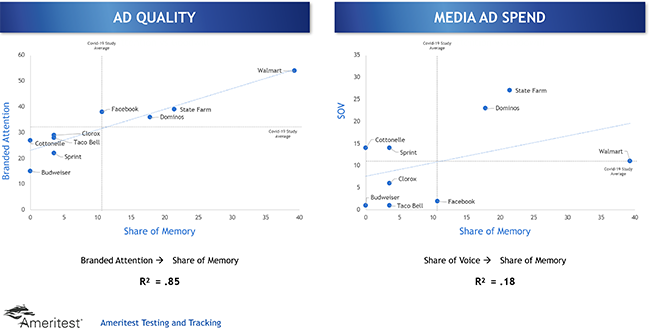
There were various reasons for differences in ad quality, which is measured by branded attention. Some ads contained more news, such as the Domino’s announcement of “contact-free” pizza delivery or the Cottonelle announcement that we’re not going to run out of toilet paper. Some ads leveraged inspirational music, while others reinforced important messages: Clorox lectured us on the importance of regular cleaning and Facebook reminded us that “we’re never lost if we can find each other.”
But Walmart outperformed all others across all key performance metrics (Figure 4) with its Heroes advertisement. It celebrated the 1 million Walmart employees who kept working to keep the shelves stocked during the crises.
Figure 4
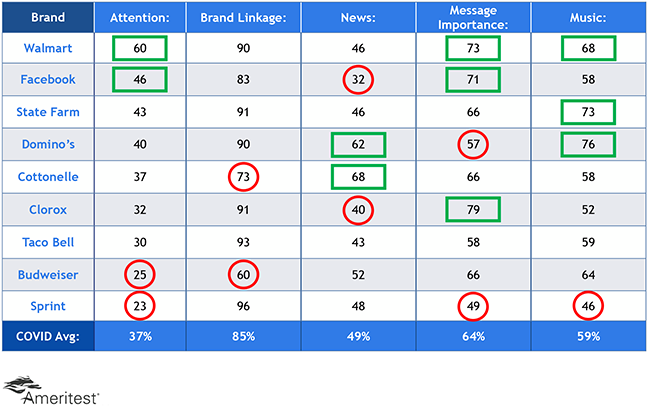
The key metric that we look at when measuring the net effect of all marketing activity in a category at any given point in time is the ratio of share-of-memory to share-of-voice. This ratio is a simple and fast-moving leading indicator of marketing performance. It’s the first measure to go up when your advertising is working to grow your brand. It’s also the first do go down when share-of-market starts to decline. A ratio greater than 1 means a brand is efficiently leveraging the money invested in media with high-quality creative.
The ratio of share-of-memory to share-of-voice for the Walmart ad was 3.5, well above the scores of the other COVID-19 ads, which mostly scored below 1. Walmart amplified the impact of its media spend on consumer memory by over three-and-a-half times because of the quality of its ad.
So, with one genius marketing move and one home-run ad, Walmart used the crisis to successfully reposition its brand from being a store that sells lots of stuff at everyday low prices to being perceived as a service company you can trust. By doing this, it is continuing to very successfully compete with its archnemesis, Amazon.
Linked in the memories
If we want to draw a conclusion about the lasting impact of these nine ads on our shared cultural memories from this year, then we need to map the visual images together into the same network to understand how they are linked in the memories of the American TV-viewing audience.
To better think about this, there are two metaphors that can shape our understanding and insights into how memory works. The first is that memory is like a library. It’s organized for search and retrieval by using a Dewey Decimal System for the mind. This is the brain of law, of logic and mathematics. It is Daniel Kahneman’s System 2 memory model for the rational, thinking brain. This model helps us understand the importance of tagging experience with various word labels to help us sort experiences in various categories that can be remembered.
The second metaphor is to think of memory as a social network with images forming the nodes of the multidimensional network instead of people. This is the System 1 Memory system. It is the intuitive, irrational memory system. This model of memory helps us understand the importance of relationship, connectivity and context in creating lasting memories.
Ameritest uses a tool to map the network of remembered visual images left behind by an ad or campaign. The resulting memory maps show the linkages, based on correlated emotions, that connect the key emotion-charged visuals in a product category. These maps can be useful for revealing the entry points and visual pathways through consumer memory to drive particular behaviors, such as purchase intent, although in the case of these COVID-19 ads, the goal was to drive goodwill towards the brand (which is correlated with purchase intent).
Figure 5
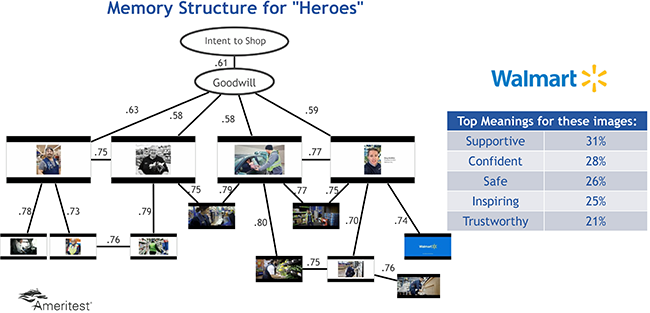
Figure 5 is the Memory Network Map for the Walmart Heroes ad. It shows that Walmart CEO Doug McMillion is being remembered as one of the faces of true leadership during this crisis. If we look across all nine ads in this study, we can see an even larger structure being laid down in the memories of the American population. The memory structure shown in Figure 6 highlights all the memorable images and the strength of the emotional linkages between them in the minds of the audience. Images are close together in memory and some are sparsely or richly connected to other images (and thus ideas).
Figure 6
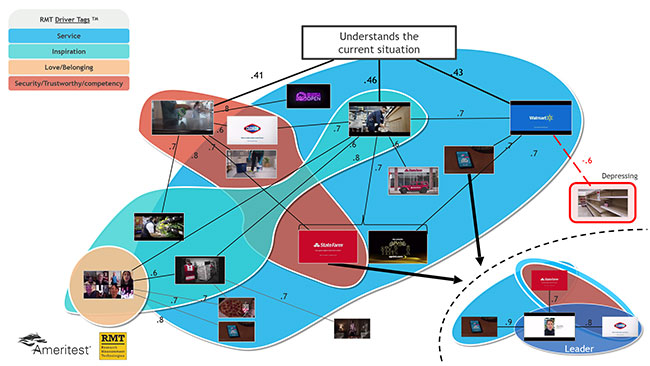
This is the foundational structure created by these nine COVID-19 ads that future rounds of advertising have the opportunity to build on. At the top of the map are the most telegraphic images that can communicate, in just a few seconds, that these brands understand the current situation.
Finally, in order for advertising to form long-term memories, it’s not just emotional content of the ad that matters but the meaning of that content. As we peel back the layers of meanings embedded in the memory network above, we can see the need for security, trust and competence. These support the higher emotional needs of love and belonging. And, at the top of this ladder of meaning is the idea of putting service to others above service to self. It seems to us that this will be an idea that will be relevant to advertisers long after the time of the coronavirus is over.
